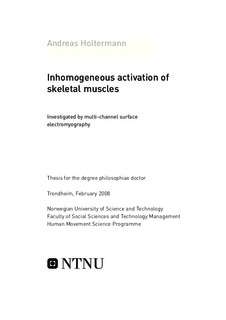| dc.contributor.author | Holtermann, Andreas | nb_NO |
| dc.date.accessioned | 2014-12-19T14:33:14Z | |
| dc.date.available | 2014-12-19T14:33:14Z | |
| dc.date.created | 2008-04-17 | nb_NO |
| dc.date.issued | 2008 | nb_NO |
| dc.identifier | 124112 | nb_NO |
| dc.identifier.isbn | 978-82-471-5966-8 | nb_NO |
| dc.identifier.uri | http://hdl.handle.net/11250/267641 | |
| dc.description.abstract | Background
The current understanding of neuromuscular control is based on the related characteristics of the motoneuron (size) and its belonging muscle fibers resulting in a stereotyped activation of all motor units within a muscle. This “size principle” was originally founded on the anatomical and histochemical non-complex soleus muscle of decerebrated cats. However, deviations from this stereotyped control are observed during voluntary contractions in anatomical complex muscles. The main objective of this thesis was to investigate intra-muscular spatial dependency of activation, control and physiological characteristics of the anatomical complex biceps brachii and trapezius muscle with a multi-channel surface electromyographical (MCsEMG) technique.
Methods
MCsEMG recordings from the biceps brachii and the trapezius muscle were performed during isometric slow force modulation and sustained sub-maximal contractions. The applied MCsEMG grid consists of 13 by 10 surface electrodes covering 6 x 4.5 cm of the skin surface. To obtain information about recruitment of motor unit populations from a large fraction of the muscles, changes in spatial distribution of activity with force modulation and fatigue were quantified by correlating the root-mean-square amplitude from all electrodes at different time-epochs within and between contraction types. Frequency and duration of repeated shifts in activity between intra-muscular regions (differential activation) were investigated by calculating the average activity level from (electrodes situated above) the two heads of the biceps brachii, respectively, throughout a sustained sub-maximal contraction until exhaustion. To examine the distribution of common synaptic input to motoneurons innervating the biceps brachii with fatigue, a descriptor for motor unit synchronization was quantified based on changes in the monopolar MCsEMG signals during a sustained contraction. To attain in vivo information about intra-muscular distribution of physiological characteristics, the muscle fiber conduction velocity and fiber orientation were estimated based on detection of propagating motor unit action potentials from large fractions of the biceps brachii and the upper trapezius muscle with the MCsEMG technique.
Main findings and conclusions
The biceps brachii and the trapezius muscle were inhomogeneously activated during force regulation and fatigue due to recruitment of differently located motor units within the muscles. The changes in spatial distribution of biceps brachii activity with force gradation were consistent within and between subjects, indicating that changes in spatial distribution of intra-muscular activity are suited to attain information about recruitment of motor unit populations. The changes in spatial distribution of upper trapezius activity were similar during sustained and ramp contractions, indicating an orderly recruitment sequence of motor unit populations during sustained contractions. The regions (long and short head) of the biceps brachii were differentially activated during a sustained contraction, indicating a partially selective control of intra-muscular regions. However, this region-dependent activation of the biceps brachii muscle was not associated with time to exhaustion at a contraction level of 25 % of maximal voluntary contraction. The motor unit synchronization descriptor was different between regions within the biceps brachii muscle with fatigue, indicating an uneven distribution of common synaptic input to the motoneurons of the muscle. Consistent with studies of human cadavers, the muscle fiber characteristics were dependent on the intra-muscular regions of the upper trapezius muscle. The findings from this thesis support an intramuscular spatial dependency of the activation, control and physiological characteristics of the biceps brachii and the trapezius muscle. | nb_NO |
| dc.language | eng | nb_NO |
| dc.publisher | Fakultet for samfunnsvitenskap og teknologiledelse | nb_NO |
| dc.relation.ispartofseries | Doktoravhandlinger ved NTNU, 1503-8181; 2008:8 | nb_NO |
| dc.relation.haspart | Holtermann, Andreas; Roeleveld, Karin; Karlson, J. Stefan. Inhomogeneities in muscle activation reveal motor unit recruitment. Journal of Electromyography and Kinesiology. 15: 131-137, 2005. | nb_NO |
| dc.relation.haspart | Holtermann, Andreas; Roeleveld, Karin. EMG amplitude distribution changes over the upper trapezius muscle are similar in sustained and ramp contractions. Acta Physiologica. 186(2): 159-168, 2006. | nb_NO |
| dc.relation.haspart | Holtermann, Andreas; Grönlund, Christer; Karlson, J. Stefan; Roeleveld, Karin. Differential activation of regions within the biceps brachii muscle during fatigue. Acta Physiologica. 192(4): 559-567, 2008. | nb_NO |
| dc.relation.haspart | Holtermann, Andreas; Grönlund, Christer; Karlson, J. Stefan; Roeleveld, Karin. Motor unit synchronization during fatigue: Described with a novel sEMG method based on large motor unit samples. Journal of Electromyography and Kinesiology, 2008. | nb_NO |
| dc.relation.haspart | Holtermann, Andreas; Grönlund, Christer; Karlson, J. Stefan; Roeleveld, Karin. Spatial distribution of active muscle fibre characteristics in the upper trapezius muscle and its dependency on contraction level and duration. Journal of Electromyography and Kinesiology, 2008. | nb_NO |
| dc.title | Inhomogeneous activation of skeletal muscles. Investigated by multi-channel surface electromyography | nb_NO |
| dc.type | Doctoral thesis | nb_NO |
| dc.contributor.department | Norges teknisk-naturvitenskapelige universitet, Fakultet for samfunnsvitenskap og teknologiledelse, Institutt for sosialt arbeid og helsevitenskap | nb_NO |
| dc.description.degree | PhD i helsevitenskap | nb_NO |
| dc.description.degree | PhD in Health Science | en_GB |
